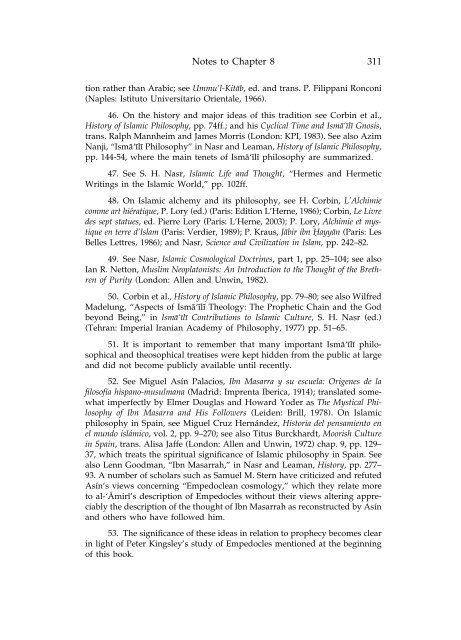Islamic Philosophy from Its Origin to the Present: Philosophy in the ...
Islamic Philosophy from Its Origin to the Present: Philosophy in the ...
Islamic Philosophy from Its Origin to the Present: Philosophy in the ...
Create successful ePaper yourself
Turn your PDF publications into a flip-book with our unique Google optimized e-Paper software.
Notes <strong>to</strong> Chapter 8 311<br />
tion ra<strong>the</strong>r than Arabic; see Ummu’l-Kitåb, ed. and trans. P. Filippani Ronconi<br />
(Naples: Istitu<strong>to</strong> Universitario Orientale, 1966).<br />
46. On <strong>the</strong> his<strong>to</strong>ry and major ideas of this tradition see Corb<strong>in</strong> et al.,<br />
His<strong>to</strong>ry of <strong>Islamic</strong> <strong>Philosophy</strong>, pp. 74ff.; and his Cyclical Time and Ismå‘¥l¥ Gnosis,<br />
trans. Ralph Mannheim and James Morris (London: KPI, 1983). See also Azim<br />
Nanji, “Ismå‘¥l¥ <strong>Philosophy</strong>” <strong>in</strong> Nasr and Leaman, His<strong>to</strong>ry of <strong>Islamic</strong> <strong>Philosophy</strong>,<br />
pp. 144-54, where <strong>the</strong> ma<strong>in</strong> tenets of Ismå‘¥l¥ philosophy are summarized.<br />
47. See S. H. Nasr, <strong>Islamic</strong> Life and Thought, “Hermes and Hermetic<br />
Writ<strong>in</strong>gs <strong>in</strong> <strong>the</strong> <strong>Islamic</strong> World,” pp. 102ff.<br />
48. On <strong>Islamic</strong> alchemy and its philosophy, see H. Corb<strong>in</strong>, L’Alchimie<br />
comme art hiératique, P. Lory (ed.) (Paris: Edition L’Herne, 1986); Corb<strong>in</strong>, Le Livre<br />
des sept statues, ed. Pierre Lory (Paris: L’Herne, 2003); P. Lory, Alchimie et mystique<br />
en terre d’Islam (Paris: Verdier, 1989); P. Kraus, Jåbir ibn ¡ayyån (Paris: Les<br />
Belles Lettres, 1986); and Nasr, Science and Civilization <strong>in</strong> Islam, pp. 242–82.<br />
49. See Nasr, <strong>Islamic</strong> Cosmological Doctr<strong>in</strong>es, part 1, pp. 25–104; see also<br />
Ian R. Net<strong>to</strong>n, Muslim Neopla<strong>to</strong>nists: An Introduction <strong>to</strong> <strong>the</strong> Thought of <strong>the</strong> Brethren<br />
of Purity (London: Allen and Unw<strong>in</strong>, 1982).<br />
50. Corb<strong>in</strong> et al., His<strong>to</strong>ry of <strong>Islamic</strong> <strong>Philosophy</strong>, pp. 79–80; see also Wilfred<br />
Madelung, “Aspects of Ismå‘¥l¥ Theology: The Prophetic Cha<strong>in</strong> and <strong>the</strong> God<br />
beyond Be<strong>in</strong>g,” <strong>in</strong> Ismå‘¥l¥ Contributions <strong>to</strong> <strong>Islamic</strong> Culture, S. H. Nasr (ed.)<br />
(Tehran: Imperial Iranian Academy of <strong>Philosophy</strong>, 1977) pp. 51–65.<br />
51. It is important <strong>to</strong> remember that many important Ismå‘¥l¥ philosophical<br />
and <strong>the</strong>osophical treatises were kept hidden <strong>from</strong> <strong>the</strong> public at large<br />
and did not become publicly available until recently.<br />
52. See Miguel Asín Palacios, Ibn Masarra y su escuela: Origenes de la<br />
filosofía hispano-musulmana (Madrid: Imprenta Iberica, 1914); translated somewhat<br />
imperfectly by Elmer Douglas and Howard Yoder as The Mystical <strong>Philosophy</strong><br />
of Ibn Masarra and His Followers (Leiden: Brill, 1978). On <strong>Islamic</strong><br />
philosophy <strong>in</strong> Spa<strong>in</strong>, see Miguel Cruz Hernández, His<strong>to</strong>ria del pensamien<strong>to</strong> en<br />
el mundo islámico, vol. 2, pp. 9–270; see also Titus Burckhardt, Moorish Culture<br />
<strong>in</strong> Spa<strong>in</strong>, trans. Alisa Jaffe (London: Allen and Unw<strong>in</strong>, 1972) chap. 9, pp. 129–<br />
37, which treats <strong>the</strong> spiritual significance of <strong>Islamic</strong> philosophy <strong>in</strong> Spa<strong>in</strong>. See<br />
also Lenn Goodman, “Ibn Masarrah,” <strong>in</strong> Nasr and Leaman, His<strong>to</strong>ry, pp. 277–<br />
93. A number of scholars such as Samuel M. Stern have criticized and refuted<br />
Asín’s views concern<strong>in</strong>g “Empedoclean cosmology,” which <strong>the</strong>y relate more<br />
<strong>to</strong> al-‘≈mir¥’s description of Empedocles without <strong>the</strong>ir views alter<strong>in</strong>g appreciably<br />
<strong>the</strong> description of <strong>the</strong> thought of Ibn Masarrah as reconstructed by Asín<br />
and o<strong>the</strong>rs who have followed him.<br />
53. The significance of <strong>the</strong>se ideas <strong>in</strong> relation <strong>to</strong> prophecy becomes clear<br />
<strong>in</strong> light of Peter K<strong>in</strong>gsley’s study of Empedocles mentioned at <strong>the</strong> beg<strong>in</strong>n<strong>in</strong>g<br />
of this book.

















